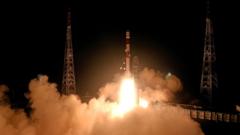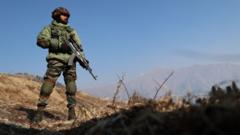On December 30, 2022, the Indian Space Research Organisation (Isro) made history by successfully conducting its inaugural space-docking test, paving the way for future endeavors such as an Indian space station and crewed lunar missions. The mission, titled SpaDeX (Space Docking Experiment), launched from the Sriharikota launch pad. Two spacecraft, referred to as the Chaser (SDX01) and the Target (SDX02), were deployed together on a single rocket and later separated in space.
Historic Space-Docking Milestone Achieved by Isro

Historic Space-Docking Milestone Achieved by Isro
India's space agency concludes successful SpaDeX mission, symbolizing a leap toward an ambitious future in space exploration.
After several delays, the docking event was executed with precision as the two spacecraft, each weighing roughly 220kg, approached one another until they were just three meters apart. Following very controlled maneuvers, scientists successfully latched the connectors of both crafts, solidifying India's position as the fourth nation globally to achieve this feat, following the United States, Russia, and China.
PM Narendra Modi, witnessing the event from Isro’s Bangalore office, lauded the accomplishment as a crucial advancement for India's prospective space missions. He remarked on social media that this achievement represents “a significant stepping stone” for future explorations.
The docking had initially been slated for January 7, but was postponed to allow for additional simulations and testing. Isro officials noted they had to meticulously control the two crafts' speeds to establish a distance of 10-20km before initiating the docking process. The successful operation included challenges, such as glitches while closing the gap between the spacecraft.
Upon completion of the docking, researchers began experiments aimed at demonstrating the potential for power transfer between the Chaser and the Target. This experiment is important for showcasing the feasibility of maintenance services for spacecraft in orbit. Furthermore, the mission will assess inter-satellite communication capabilities essential for future operations.
In addition to these ground-breaking operations, the SpaDeX mission is equipped with scientific instruments designed to monitor radiation and assess Earth’s natural resources. It also features a microgravity experiment that recently achieved successful seed germination, indicating the potential for sustainable food production in space.
As Isro continues to innovate in space exploration, the applications of this successful docking test are expected to yield valuable insights, especially for upcoming missions like Gaganyaan, India's first human spaceflight program, and future lunar explorations, including Chandrayaan-4.
Following this successful milestone, Isro is determined to push boundaries further in its quest for space exploration and development, solidifying India's role in the global space community.
PM Narendra Modi, witnessing the event from Isro’s Bangalore office, lauded the accomplishment as a crucial advancement for India's prospective space missions. He remarked on social media that this achievement represents “a significant stepping stone” for future explorations.
The docking had initially been slated for January 7, but was postponed to allow for additional simulations and testing. Isro officials noted they had to meticulously control the two crafts' speeds to establish a distance of 10-20km before initiating the docking process. The successful operation included challenges, such as glitches while closing the gap between the spacecraft.
Upon completion of the docking, researchers began experiments aimed at demonstrating the potential for power transfer between the Chaser and the Target. This experiment is important for showcasing the feasibility of maintenance services for spacecraft in orbit. Furthermore, the mission will assess inter-satellite communication capabilities essential for future operations.
In addition to these ground-breaking operations, the SpaDeX mission is equipped with scientific instruments designed to monitor radiation and assess Earth’s natural resources. It also features a microgravity experiment that recently achieved successful seed germination, indicating the potential for sustainable food production in space.
As Isro continues to innovate in space exploration, the applications of this successful docking test are expected to yield valuable insights, especially for upcoming missions like Gaganyaan, India's first human spaceflight program, and future lunar explorations, including Chandrayaan-4.
Following this successful milestone, Isro is determined to push boundaries further in its quest for space exploration and development, solidifying India's role in the global space community.




















